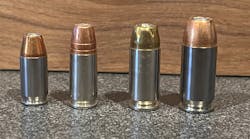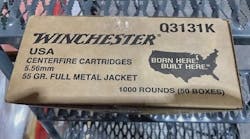Editor’s Note: In this article you will see the following terms: Internal Ballistics (what happens inside the weapon), External Ballistics (the projectile’s performance between exiting the barrel of the weapon and impacting the target), Terminal Ballistics (what the projectile does upon impacting the target).
Most law enforcement officers simply use what the agency issues them—no matter who the manufacturer is, the projectile design, the projectile weight, type of jacket, etc. However, for the officers on a given agency that have to make recommendations for training and duty ammunition and for those officers who have options in what they choose to load their off-duty weapons with, the question of contemporary ammo characteristics comes into play.
The past 100 years have seen huge advances in metallurgy, weapon design, magazine capacities, and more. From the days of 1911 when the Government Model with its 7+1 capacity was “state of the art” to today’s options of subcompact 9mm handguns touting 3″ barrels and 12+ round magazine capacity, much has changed. In metallurgy and mechanical design, the capacity of weapons related to internal ballistics has advanced. One example is how the .45ACP and the .45GAP perform. Today’s technology allows the .45GAP to have much different internal ballistics as compared to the .45ACP, but externally and terminally the ballistics (mathematically) are the same.
Yes, much has changed.
What hasn’t is the need of the agency to equip officers with duty ammunition that will fulfill the primary function as efficiently as possible: that being to stop potentially lethal threats. To be “efficient” duty ammunition, there are a few criteria that have to be met.
Accuracy. As much as most of us don’t like to admit it, most contemporary weapons and ammo are more accurate than we shooters are capable. That’s why there are ransom rests to test accuracy. While being able to shoot a dime off a post at 100 yards is an awesome capability, the more realistic expectation is 2″ to 3″ groups with controlled fire accuracy at 25 yards. For the most part, all contemporary ammunition is capable of this. Most quality weapons are equally capable. The trick, if you’re really looking for it, is to test several ammo types to find out specifically which is most accurate in your chosen firearm. This is something many precision marksmen do, but isn’t something usually taken into consideration by the average officer. In fact, most agencies select duty ammo based on other performance characteristics.
Bullet weight and out-of-the-barrel velocity are often discussed and definitely play a role in terminal ballistics. With the most common duty calibers today being 9mm, .40S&W and .45ACP, bullet weight can range from as light as 115g to as heavy as 230g. Basic math and engineering says that the faster we push higher weight projectiles, the more energy we deliver to the target and the more effective our terminal ballistics performance can be. However, the limits of pushing heavier projectiles to faster speeds are created within the firing chamber itself and internal ballistics do have limitations on containing the expansion of burning propellant behind the projectile. The faster we push the projectiles, the more wear and tear we create within the weapon, thereby shortening the service life.
In general, if we can push a projectile in one of those specified calibers out of the weapon somewhere between 1,200 and 1,400+ feet per second, we can generate the desired energy. If that projectile is of modern design using a serrated jacket around a softer but solid core, the necessary velocity on impact should create expansion of the projectile itself, thereby creating a larger permanent cavity in the target.
That brings us to the last requirement of duty ammunition: It has to penetrate deep enough and expand sufficiently to deliver the desired temporary and permanent cavity to incapacitate our target. Unless specifically designed to do so, and some ammo is (frangible or multiple projectile types), the projectile shouldn’t come apart in the target.
As you select your agency duty or off-duty ammunition, please keep all of the above in mind.




